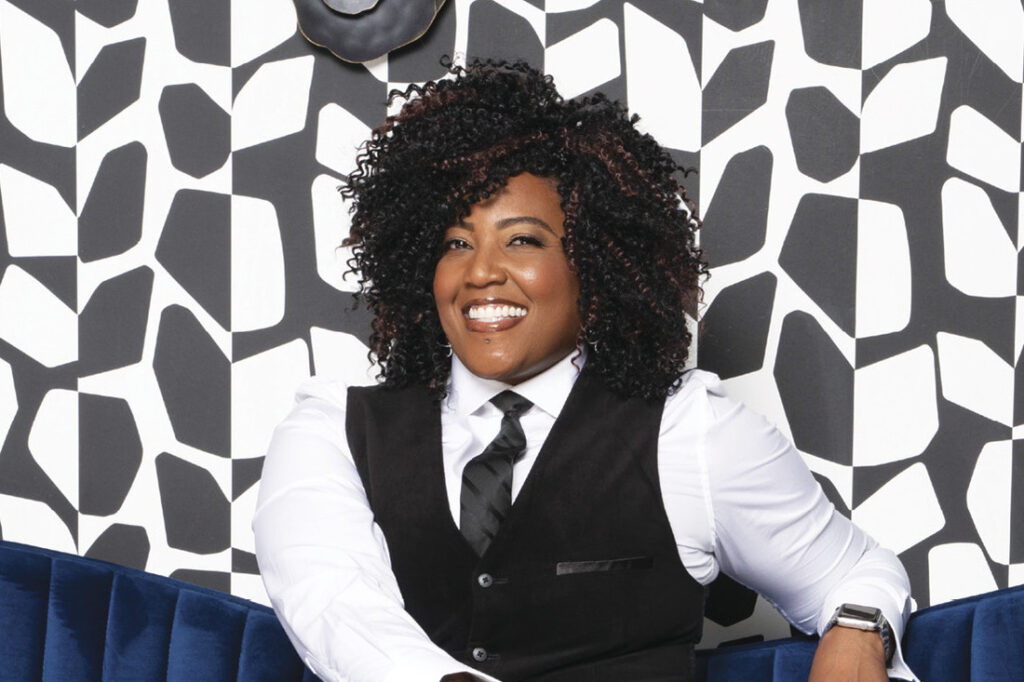All the way back around 500 B.C., Greek philosopher Heraclitus established the notion that the only constant in life is change. So why are so many of our modern workplaces so bad at it?
Change Enthusiasm® Global founder Cassandra Worthy spent 15 years in the corporate world frustrated by leaders who addressed change in the abstract but failed to support their employees through it. Since leaving that world behind in 2019, she’s focused on helping organizations thrive through these periods—particularly by harnessing emotions that can lead to personal and professional growth.
“My work is to debunk the myth that emotion should be left at the door of business,” Worthy says. “Regardless of if you talk about them, they’re still gonna be there. It’s just a matter of if they’re driving your attrition rates up. Or if they’re allowing you to move successfully through change.”
With Change Enthusiasm®, Worthy has created a program that helps organizations embrace so-called “negative” emotions around change—whether that’s a buyout, restructuring or new management—by using those emotions to fuel positive growth. She wants you to know that your emotions are worthy of interrogating in a workplace setting. And that they can, in fact, be used to propel you to a new and better place during otherwise challenging times.
We sat down with her to talk about harnessing your feelings to fuel positive growth, especially in the face of fast-paced change and disruption.
(This conversation has been edited for clarity and length.)
The start of Change Enthusiasm®
SUCCESS: Would you tell me about the origins of Change Enthusiasm®?
Cassandra Worthy: I went through a lot of change in my corporate career, and most of it was acquisition. I’ve been on both sides of the coin. I’ve been in a large organization that acquired a business for multibillion dollars…and then I’ve been a part of a business that got acquired by another large company… And every time, I’ve felt the pain, the frustration, the anger, the anxiety, the fear—not knowing if I would wake up and have a job the next day.
Reacting to change
CW: I noticed that leaders would talk about, “This is gonna be tough times; it’s gonna be difficult; we’re going through a lot of change.” They would do that at the beginning, but then nothing else would be said about the difficulty, about the challenge. It was almost like this unspoken, grit-your-teeth-and-bear-it thing. In corporate, there’s the sentiment of, “Leave your emotions at the door. We understand you’re human—you have emotions. But don’t talk about them here.”
S: Right, right. “This is not the place.”
CW: Exactly. “This is not the place. I don’t need to hear that.” This never sat well with me. And I knew there was a better way. So, I actually started practicing this mindset that I coined Change Enthusiasm® back when I was in corporate going through these acquisitions and recognizing that the feelings I was having—the fear, the frustration—they always were signaling me to some moment of opportunity. Some way to learn about myself [and] to learn about something that I didn’t like. And to learn about one of my boundaries, to learn about my colleagues [or] about the business. And it was up to me to choose. How was I gonna show up? How was I gonna use that emotional energy to work for me as opposed to against me?

Creating change with Change Enthusiasm®
CW: A culmination of things happened. I got sober back in 2014. And I recognized this whisper I had been hearing really ever since I started in corporate—that there’s something more, something different you should be doing with your goals and talents to make the world a better place. The other thing that happened was, my sister asked me how was it that I was able to thrive and grow and inspire when going through really difficult times. I had to think about, “How do I do that?”
And I actually wrote out kind of the mental process, and the steps that I take…I started sharing it with other people and corporate, and was like, “This is something I could actually bring to the world.”
S: I can see this message really resonating with women, with younger workers—the idea of accessing your emotions and harnessing them to create change. It’s a powerful thing to hear.
CW: For sure. In Change Enthusiasm®, moving from step one to step two is about stepping outside of our emotional energy. It’s about stepping outside and not becoming our anger. Not becoming our rage or our frustration and acting out in that. I use this mnemonic of a traffic light, where the opportunity is the yellow light. That’s where you’re pausing. That’s where you’re taking a beat. [And] that’s where you’re reflecting on, “What is here for me to learn? What are my options in this moment? How can I move forward, becoming better, as opposed to running that yellow light and choosing to act in anger or frustration?” People really resonate with that because it’s like, “No, slow down. Take a beat. Take a pause when you’re feeling that emotion.”
The Change Enthusiasm® framework
S: In your speaking and consulting work, do you find that there are office environments or types of people who can benefit more from this framework?
CW: Honestly, the people who can benefit the most are the people who are most resistant to embracing it. It is the executives; it is the leaders [who] have grown up in a world where emotions were not to be talked about. They hear things nowadays about emotions, and it’s like, “That’s too woo-woo; that’s too fluffy. We need to be hard-nosed. We have to remain stoic; don’t talk about emotions. They cloud decisions.”
CW: It’s these folks [who] I talk about empathy with—I talk about appreciation, [and] I talk about being your full authentic self and about Change Enthusiasm®. And it’s like they shut down to it. They say, “You can talk to my junior colleagues about it, but I don’t need it.” But it’s them who need to [be] role model[s] and embody it and bring it to the forefront if they want their change initiatives and their growth initiatives to be successful.
Embracing change then vs. now
S: Do you feel that, as time goes on, there’s maybe less resistance to ideas like this? I think I’m seeing more and more talk about ideas like emotional intelligence, for example. Are people warming to it?
CW: For sure. They have to have been. Otherwise, we wouldn’t have had the success that we’ve had to date with Change Enthusiasm® Global—and the fact that my calendar stays pretty jam-packed, which I’m so grateful for.
CW: I think there’s a turning point that’s happening. There’s an evolution that’s happening in corporate. I think a lot of it is due to the changing of [the] guard, generationally, as we think about individuals who have grown up in a different space, who are now taking on leadership positions, and also just the nature of the work.
CW: The pace of change, of disruption, is becoming more and more rapid—seismic shifts everywhere. And so, because of that, the emotional landscape is even more tumultuous than it’s ever been…I think it’s become a business imperative. And for many leaders, they’re at a point of desperation. They’re now opening their eyes and saying, “OK, let’s talk about emotions. What is this emotional intelligence thing? Let’s talk about it—if it will help.”
This article appears in the September/October issue of SUCCESS Magazine. Photo courtesy of Rious Photography (IG @Riousshotme)/courtesy of Cassandra Worthy.










